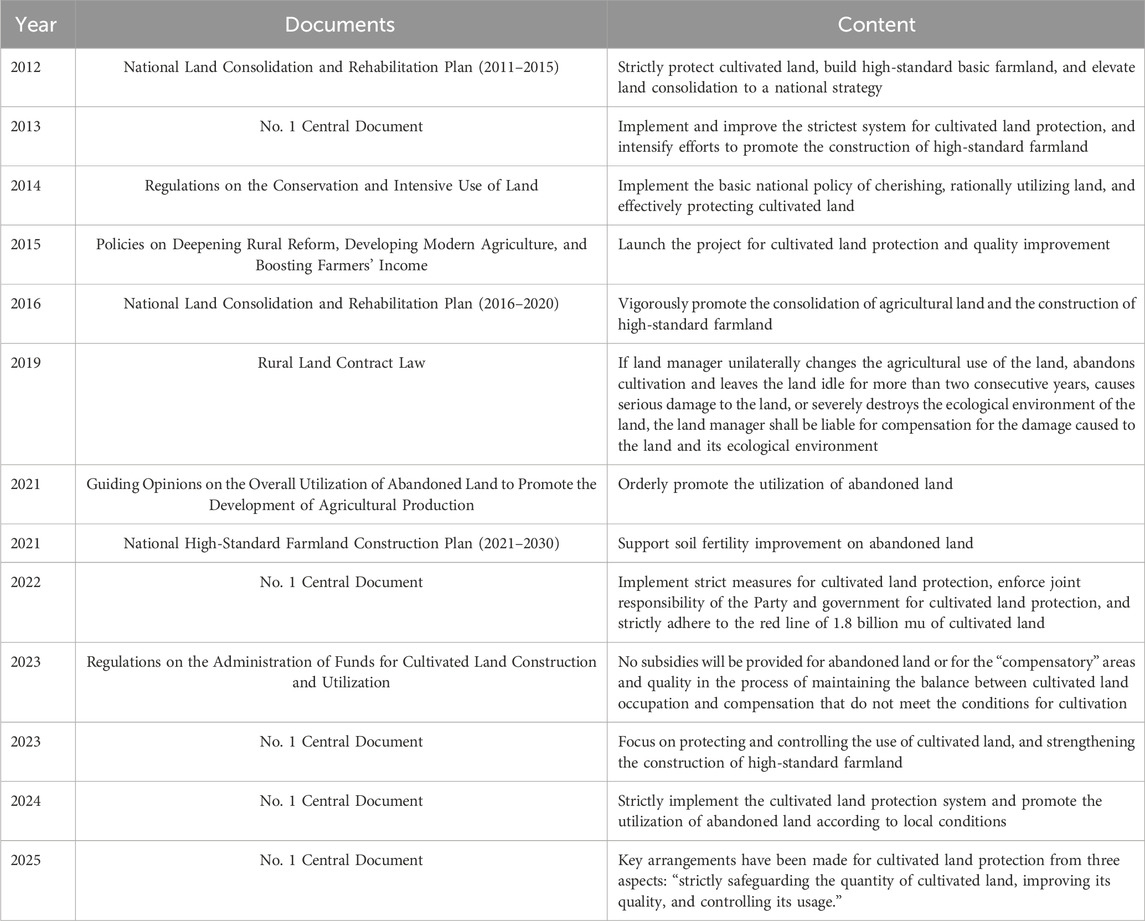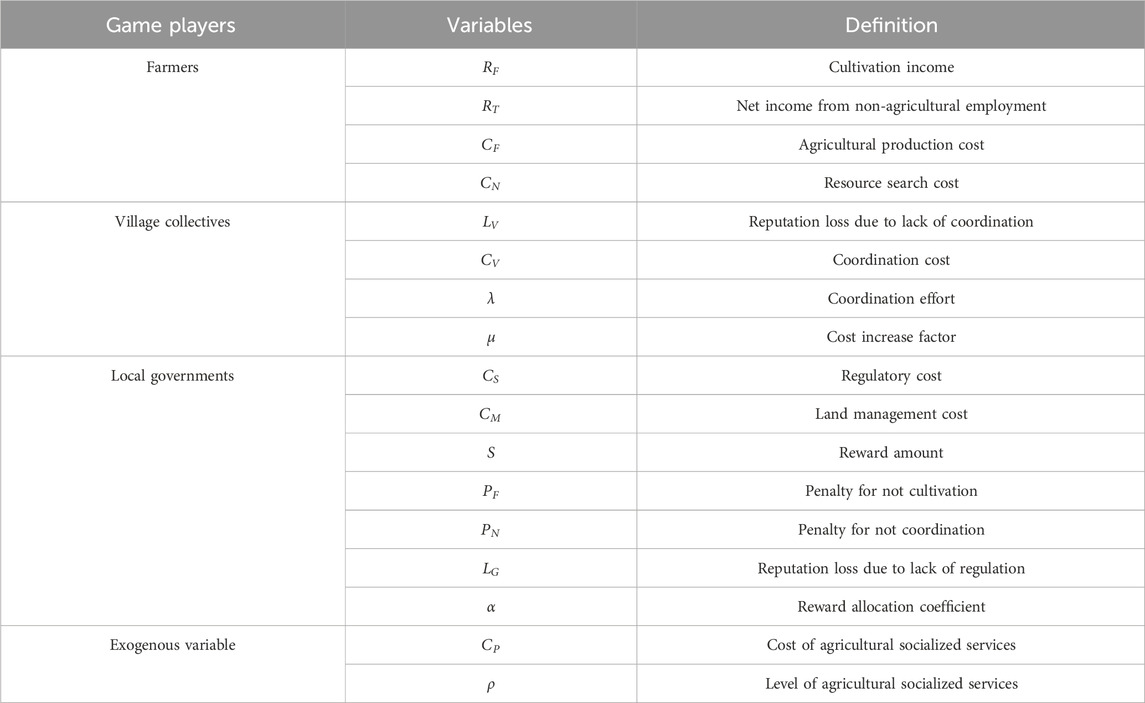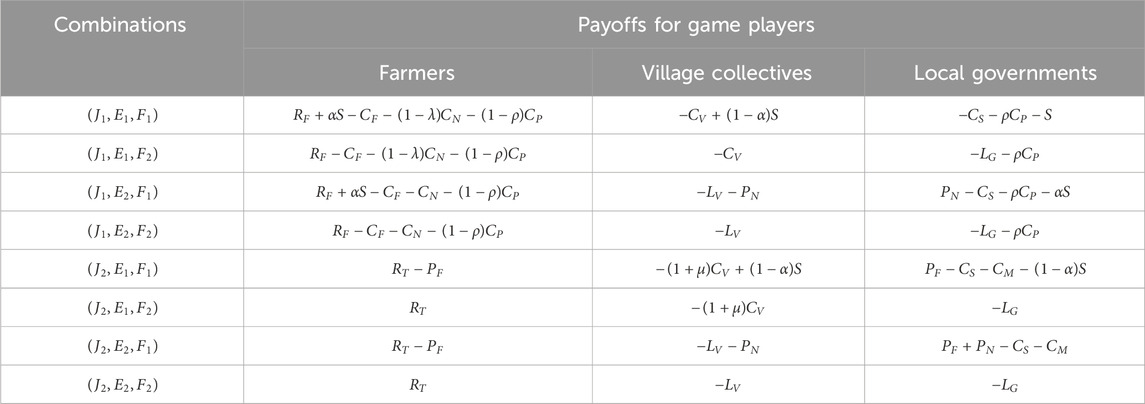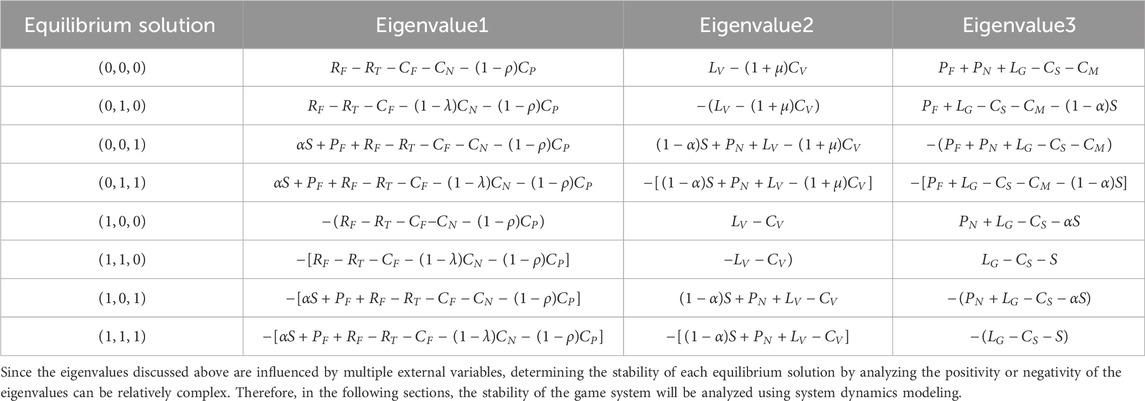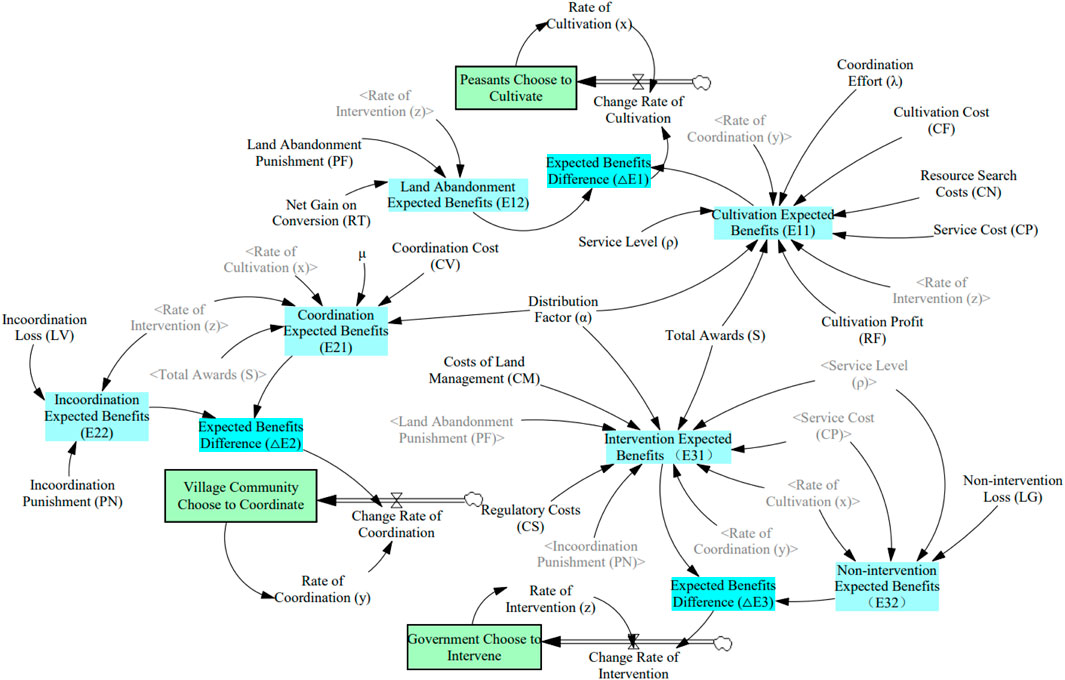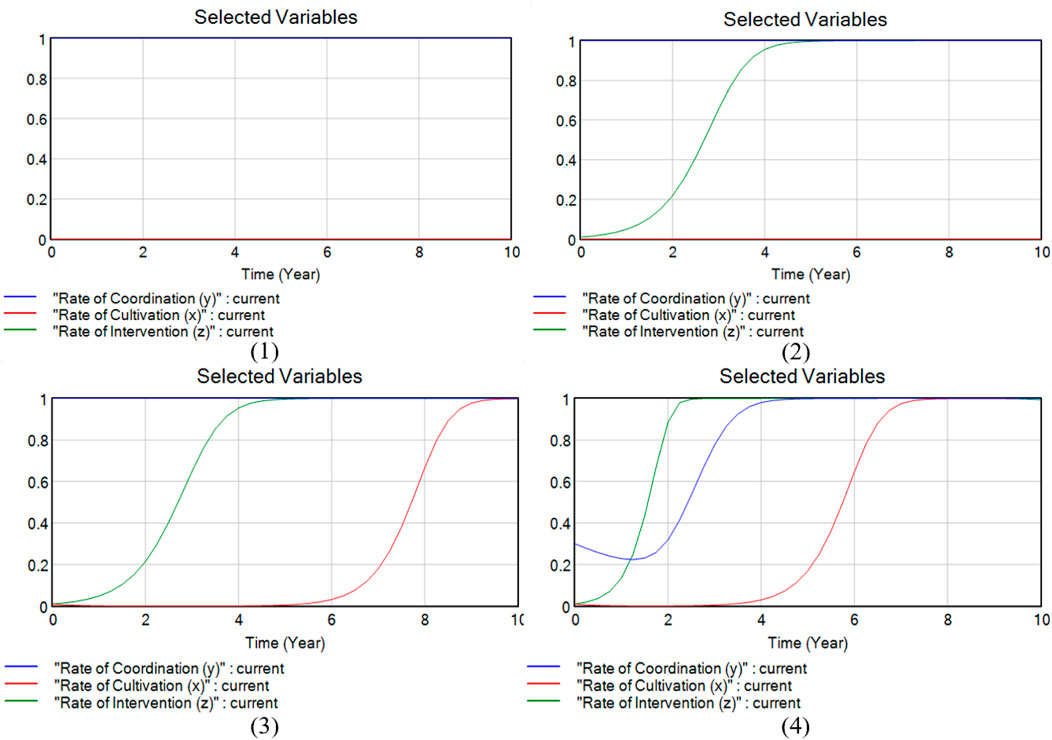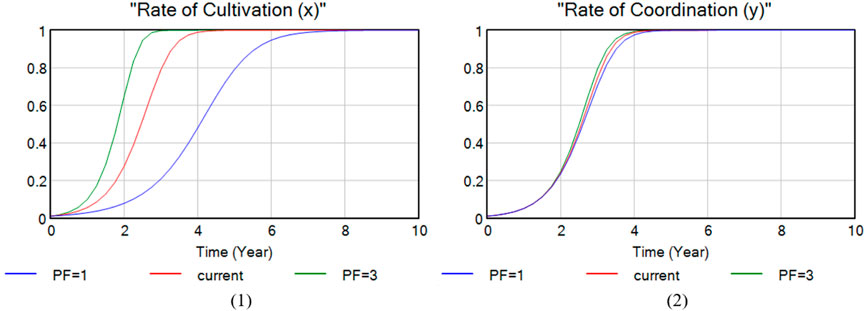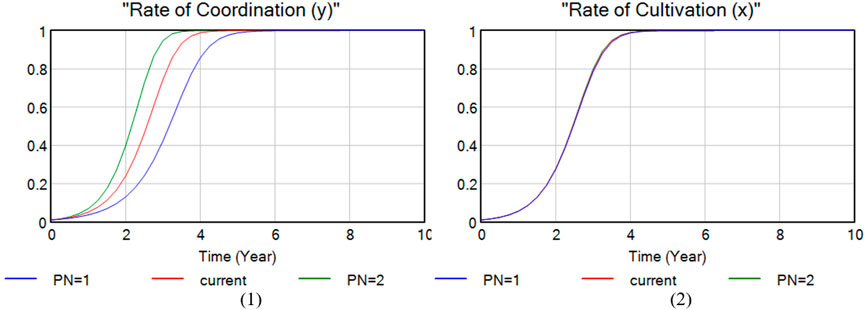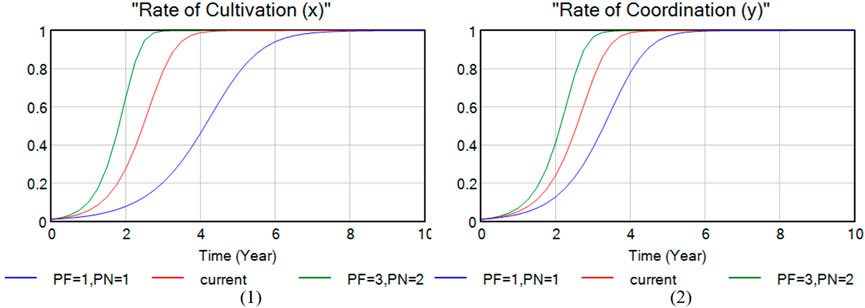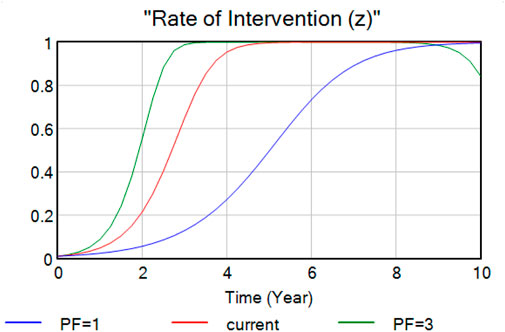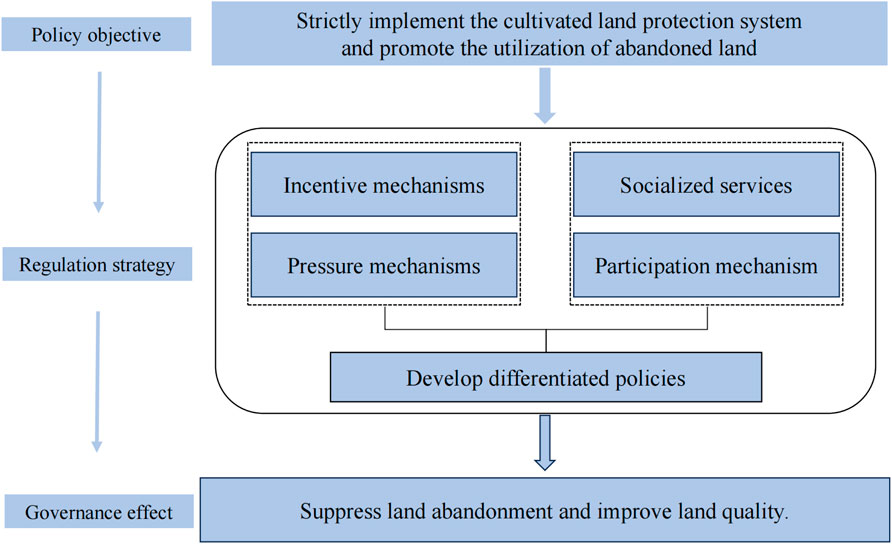- 1Business School, Wenzhou University, Wenzhou, China
- 2Student Affairs Department, Zhejiang College of Security Technology, Wenzhou, China
Introduction: Addressing the issue of land abandonment in rural areas is a critical strategy for ensuring national food security and promoting high-quality agricultural and rural development.
Methods: Based on the assumption of bounded rationality, this paper constructs an evolutionary game model involving three key stakeholders: farmers, village collectives, and local governments. By integrating system dynamics, we simulate and analyze the behavioral strategies of participants, examining the mechanisms of government regulation. Additionally, we explore the moderating role of agricultural social services and further investigate the impact of incentive and penalty measures.
Results: (1) under specific constraints, the system evolves toward the optimal equilibrium (1,1,1); (2) government policies influence the strategic choices of farmers and village collectives, with excessively high or low incentive and penalty measures proving ineffective in mitigating land abandonment; (3) compared to incentives, penalty measures exhibit a more substantial impact on addressing land abandonment; (4) enhancing agricultural social services can strengthen the effectiveness of incentive and penalty policies.
Discussion: Based on these results, the paper offers policy recommendations from four perspectives: regulatory reform, the integration of incentives and penalties, flexible subsidies, and enhanced collaboration among key stakeholders, thereby providing both theoretical insights and practical guidance for addressing land abandonment.
1 Introduction
Land is a vital natural resource for human survival and the foundation for ensuring national food security. However, with the rapid development of secondary and tertiary industries, there has been a significant shift of labor from the agricultural sector to non-agricultural sectors. This labor shortage in rural areas has led to the extensive underutilization of farmland and even the emergence of land abandonment. According to the Statistical Bulletin on the Development of Human Resources and Social Security in 2022, approximately 58% of rural labor nationwide transitioned to non-agricultural employment in China. Data from the China Rural Governance Research Center of Wuhan University revealed that the level of land abandonment nationwide was relatively high in 2023, with over 50% of the abandoned land area and an abandonment rate of approximately 17.48%. Land abandonment in China currently manifests in three key characteristics: Firstly, land abandonment is not only prevalent in the relatively underdeveloped agricultural regions of central and western China but also occurs in the more economically advanced eastern and southern regions (Zhu et al., 2021). Secondly, both explicit and implicit land abandonment coexist, with implicit abandonment being more common, particularly in areas with favorable agricultural production conditions (Huang and Li, 2009). Thirdly, most rural households have adopted a livelihood model based on intergenerational labor division, combining part-time farming with part-time employment, which has led to a shift from policy-driven land abandonment to structural land abandonment (Xia and He, 2017). The increasing trend of land abandonment exerts additional pressure on food production, threatens food security, and hampers economic development, thereby significantly obstructing the process of agricultural modernization (Khanal and Watanabe, 2006).
Existing studies on land abandonment primarily focus on its causes, impacts, and potential countermeasures. Scholars have generally categorized the causes of land abandonment into three main factors: Firstly, the development of secondary and tertiary industries has led to an increase in non-agricultural employment opportunities, resulting in a large migration of young and strong labor forces from rural areas to cities in search of better economic prospects (Levers et al., 2018). This shift has caused a significant shortage rural labor, leading to substantial land underutilization, which is widely regarded as the fundamental cause of land abandonment (Huang et al., 2023). Secondly, the cost of agricultural production has continuously increased with the development of modern technology, while the prices of agricultural products are generally low and even face the risk of falling. These low economic returns have discouraged farmers from continuing cultivation, contributing to land abandonment (Zhang et al., 2016). Thirdly, the inefficiencies in the land transfer mechanism, coupled with weak land management by grassroots organizations such as village collectives, further results in land abandonment (Chen et al., 2024; Zhang et al., 2014). In addition to these factors, natural environmental conditions, such as climate change and agricultural viability, also play a significant role in influencing land abandonment (Zhang et al., 2014; Bhawana and Race, 2020). The impact of land abandonment depends on factors such as the location, scale, and the social and natural environment of the affected area (Rey-Benayas et al., 2007; Munroe et al., 2013; Ustaoglu and Collier, 2018). On the one hand, many scholars argue that land abandonment exacerbates soil erosion and reduces biodiversity (Harden, 1996; Uematsu et al., 2010). On the other hand, large-scale abandonment can leave land resources idle, diminishing food production and impeding regional economic development (Zhu et al., 2023). However, some scholars contend that land abandonment does not necessarily correlate with a decrease in cultivated land and may not severely impact long-term food security. In fact, land abandonment could reduce the frequency of land use, thereby safeguarding the land’s overall production capacity (Zheng et al., 2023). To resolve land abandonment, a dual approach involving technological innovation and institutional reform is crucial. Scholars commonly prioritize the reconstruction of agricultural infrastructure (Liu et al., 2022), and advocate for strengthening agricultural biotechnology and information technology as effective measures to mitigate land abandonment (Munaweera et al., 2022). Furthermore, promoting the transfer of cultivated land and reinforcing the construction of new agricultural operating entities are viewed as essential and effective strategies to combat land abandonment (Zheng and chen, 2024; Zheng, 2024).
Although existing research has laid an important foundation for understanding the issue of farmland abandonment, there are still limitations in the following two aspects: First, although scholars have already explored the role of incentives and penalties in addressing land abandonment (Estacio et al., 2024; Van Leeuwen et al., 2019), their research primarily focuses on theoretical analysis or the evaluating the effectiveness of a single policy. There is a lack of differentiated analysis of incentives and penalties, and the combined effects of multiple policy tools are also overlooked. Second, land abandonment is a complex process that involves multiple stakeholders, long timeframes, and dynamic changes. Existing research, however, often adopts a single-stakeholder or static perspective, overlooking the intricate interactions and evolving behaviors of the involved parties. Although some preliminary studies have approached this issue from the perspectives of the government and farmers (Sun et al., 2025), the crucial role of village collectives has often been neglected. In China’s agricultural structure, characterized by a “big country, small farmers” model, village collectives play a pivotal role in land management, policy promotion, and benefit distribution. Including village collectives within the research framework for land abandonment governance would offer a more comprehensive understanding of the interactions and collaborative relationships among various stakeholders involved in land governance.
Based on these considerations, this paper aims to address the following essential questions:
• How do the decisions of farmers, village collectives, and local governments interact and affect the evolution of system stability?
• How can incentive and penalty mechanisms curb land abandonment?
• How can government incentive and penalty policies be improved in the context of the development of agricultural socialized services to enhance land use efficiency?
Evolutionary game theory is a robust tool for analyzing the behavior and strategy evolution of individuals in complex systems (Xie et al., 2018). System dynamics, on the other hand, is a simulation method that integrates both qualitative and quantitative analysis, emphasizing development, connectivity, and movement. It is commonly used to simulate the structure of complex systems and analyze their dynamic changes over time (Forrester, 1987). This study combines evolutionary game theory with system dynamics to construct a tripartite evolutionary game model involving farmers, village collectives and local governments, exploring potential equilibrium points, the stability conditions under which the three stakeholders reach an equilibrium state, and the sensitivity of key variables to examine the system’s evolutionary process. Building on this, the study further incorporates the level of agricultural socialized services and analyzes the effects of government incentive and penalty policies under different scenarios, aiming to provide a more comprehensive perspective for addressing the issue of land abandonment.
Comparing with existed literature, this paper makes the following three contributions:
First, this paper fully considers the coordination role of village collectives in land management, constructing a dynamic game model involving local governments, village collectives, and farmers to characterize the long-term dynamic effects of government incentive and penalty policies on land abandonment.
Second, from a micro perspective, the study thoroughly examines the mechanisms of incentive and penalty policies, comparing the effects and interactions of these measures in the governance of land abandonment.
Third, the study further analyzes the mechanism of incentive and penalty policies by considering the moderating effect of regional agricultural socialized services. Given the differences in the levels of agricultural socialized services, farmers’ responses to incentive and penalty policies may vary. This underscores the critical role of agricultural socialized services in policy implementation and farmer decision-making, offering both theoretical foundations and practical guidance for formulating targeted incentive and penalty measures in different regions.
The rest of this paper is organized as follows: Section 2 provides the research background and theoretical analysis. Sections 3 constructs evolutionary game model. Section 4 incorporates system dynamics for numerical simulation and sensitivity analysis. The conclusions and implications are explained in Section 5.
2 Research background and theoretical analysis
2.1 Land abandonment
Land abandonment refers to the phenomenon where suitable arable land is left uncultivated and deliberately allowed to lie idle and become wasteland, and it can be classified into narrow and broad senses. In the narrow sense, land abandonment typically refers to farmers either giving up their existing land or reducing cultivation, resulting in land being left fallow, encompassing both permanent and seasonal abandonment (Tan, 2004). For instance, the Food and Agriculture Organization (FAO) of the United Nations defines abandoned land as arable land that has not been used for agricultural production for more than 5 years. Broadly speaking, land abandonment includes not only the idleness or cessation of farming activities on farmland but also the underutilization of land resources, encompassing both visible and hidden forms of abandonment (Huang and Li, 2009).
From a global perspective, Europe began experiencing land abandonment in the early 20th century due to a continuous decline in population, with the phenomenon spreading from the 1950s onward (Dolton-Thornton, 2021). Large-scale land abandonment in mountainous regions occurred in the mid to late 20th century. Even today, land abandonment remains prevalent in many countries across North America, Europe, and beyond (Subedi et al., 2022). In China, large-scale land abandonment began in the 1980s. The reform of the rural management system improved agricultural productivity, leading to a surplus of agricultural products. At the same time, rapid urban economic development provided farmers with numerous non-agricultural employment opportunities, triggering a wave of rural migration and subsequent large-scale land abandonment. In 1992, the promotion of the second round of land contract policies alleviated the problem of land abandonment to some extent. However, after 1997, a surplus of agricultural products emerged again, leading to increased production without corresponding income growth, and land abandonment began to spread once more. Following the agricultural tax reform in 2004, farmers’ enthusiasm for grain production was stimulated in the short term, helping to contain land abandonment to some degree. Nevertheless, as the policy effects waned and even negative incentives emerged, land abandonment resurged and began to show increasingly severe trends. Currently, land abandonment has become a widespread issue in China, with approximately two million square kilometers of cultivated land being abandoned annually. According to the Third National Land Survey released in 2021, the total area of cultivated land in China is approximately 12.78 million hectares. Land abandonment not only contributes to soil erosion and affects biodiversity, but also poses a threat to food security and hinders economic development. In recent years, to curb the further deterioration of land abandonment, maintain the red line of 1.8 billion acres of arable land, and ensure food security, the Chinese government has implemented a series of policy measures, as shown in Table 1.
2.2 Theoretical analysis
Public policy is regarded as a series of collective goals formulated by governments to guide and improve behaviors aimed at solving individual or collective problems. It reflects the authoritative distribution of public interests by the government for society as a whole. The primary objective of public policy is to communicate policy intentions from policymakers to recipients, thereby facilitating policy implementation (Roth Deubel, 2006). Land policy primarily promotes land governance through the dissemination and guidance of policy information among the government, agricultural support organizations, and agricultural producers. Public policy tools for land governance in China exhibit the following characteristics: First, policy tools vary depending on the target audience, with a predominance of negative incentive tools. Second, policy tools continue to evolve over time (Wang, 2017).
The primary avenues through which public policy addresses land abandonment are incentive mechanisms and pressure mechanisms (Tian, 2013). Incentive mechanisms reduce or eliminate the potential for non-cooperation among stakeholders, thereby positively influencing system performance (Haddi and Benchaïba, 2015). These mechanisms primarily focus on material subsidies and can be broadly categorized into three types: result-based payments, action-based payments, and hybrid payments (Raina et al., 2024). The governance of land abandonment heavily depends on the guidance and support provided by governments. From a top-level design perspective, the government comprehensively considers various factors such as the rational use of land resources, the protection of the ecological environment, and the safeguarding of farmers’ interests to establish effective incentive mechanisms. Pressure mechanisms, on the other hand, refer to rigid regulations and limitations in policy implementation, which significantly affect the behavioral choices of stakeholders. Insufficient or absent authoritative constraints may lead to negative behaviors such as evasion, flexibility, and non-cooperation. Pressure mechanisms are essential for ensuring the effectiveness of land governance, primarily manifested in the establishment of a responsibility investigation mechanism by governments using their authority. By clarifying the responsibilities of all stakeholders, these constraints penalize farmers for abandoning land and village collectives for uncoordinated actions, thereby maximizing the speculative costs for responsible parties and suppressing land abandonment.
2.3 Evolutionary game
Traditional game theory models typically focus on static equilibrium analysis, assuming that all participants make instantaneous decisions based on complete information. However, these static models often overlook the dynamics in the decision-making process and the constantly changing patterns of interaction among participants, especially in complex systems where decision-makers frequently face incomplete information and bounded rationality. Evolutionary game theory is a generalized approach for studying agent interactions and strategic choices, establishing models based on replicator dynamics equations and evolutionarily stable states, which represent the stable states of evolutionary games and the dynamic convergence process towards these states, respectively (Zhao et al., 2024). Compared to the static equilibrium of traditional game theory, evolutionary game theory addresses issues of limited rationality and learning mechanisms. By utilizing replicator dynamics and evolutionarily stable states, it captures the evolution of strategies during long-term interactions, making it a powerful tool for analyzing individual behavior and strategic evolution in complex systems (Xie et al., 2018; Coninx et al., 2018).
Addressing land abandonment requires the collaborative involvement of farmers, village collectives, and local governments. Farmers are the direct beneficiaries of improvements in land abandonment and play a key role in land governance. They must consider external incentive and penalty policies, their own development conditions, and prospects for non-agricultural employment when deciding whether to engage in agricultural production, with the goal of maximizing their benefits. Government support for land governance is reflected in three main areas: first, introducing relevant incentive policies to stimulate farmers’ production enthusiasm; second, strengthening supervision over land abandonment and implementing penalty measures to regulate abandonment behaviors; and third, enhancing the development of agricultural socialized services to support agricultural production. As an intermediary organization, the village collective plays a coordinating role in facilitating communication and ensuring the effective implementation of policies.
Based on the above analysis, the theoretical framework constructed in this study is shown in Figure 1.
3 Model assumptions and construction
3.1 Model assumptions
Evolutionary game models are commonly employed to analyze the evolution of individual behaviors and strategies within complex systems, where the evolutionary process is often influenced by external environments, individual characteristics, and interaction rules. Reasonable assumptions not only help to eliminate secondary interfering variables and focus on the core driving mechanisms but also ensure the logical consistency of mathematical derivations. Furthermore, clear assumptions aid in defining the scope of the study, making the conclusions more persuasive and applicable. Therefore, to construct game models in a more scientific and rational manner, and to clearly elucidate the stability of strategies and equilibrium points among various parties as well as the influence relationships among different elements, this paper proposes the following assumption:
Assumption 1. One of the central principles of evolutionary game theory is that agents participate in repeated games under the assumption of bounded rationality until the game system evolves toward a stable state over time (Weibull, 1997). This model involves three primary stakeholders: farmers, village collectives and local governments. Each of these stakeholders operates under bounded rationality, continuously learning from one another throughout the game process to make decisions that best align with the evolving environment and their own interests.
Assumption 2. Farmers, as direct participants in agricultural production, and there are two strategies for land use. The first strategy is to cultivate, which is denoted as
Assumption 3. Village collectives, as coordinators, and there are also two strategies. The first strategy is to coordinate, which is denoted as
Assumption 4. Local governments, as administrators, have two strategies. The first strategy is to regulate, which is denoted as
The variables and their denotations used in this paper are listed in Table 2.
Different strategies will bring different profits. According to the various combinations of strategies and the corresponding profits, the game payoff matrix is shown in Table 3.
3.2 Construction and solution of the evolutionary game model
3.2.1 Expected revenue function of farmers
The expected revenue for farmers choosing to cultivate or abandon their land, as well as the average expected revenue, are
3.2.2 Expected revenue function of village collectives
The expected revenue for village collectives choosing coordination or incoordination, as well as the average expected revenue, are
3.2.3 Expected revenue function of local governments
The expected revenue for local governments choosing to intervene or not to intervene as well as the average expected revenue, are
The replication dynamic equations for farmers, village collectives, and Local governments are expressed by Equation 10.
3.3 Analysis of local stability strategy
3.3.1 Farmers
The replicator dynamics equation for Farmers can be derived as Equation 11:
Take the partial derivative with respect to x, as shown in Equation 12:
Let:
According to the stability conditions of the replicator dynamic equation, when
(1) When
(2) When
3.3.2 Village collectives
The replicator dynamics equation for Village collectives can be derived as Equation 14:
Take the partial derivative with respect to y, as shown in Equation 15:
Let:
According to the stability conditions of the replicator dynamic equation, when
(1) When
(2) When
3.3.3 Local governments
The replicator dynamics equation for 3 Local governments can be derived as Equation 17:
Take the partial derivative with respect to z, as shown in Equation 18:
Let:
According to the stability conditions of the replicator dynamic equation, when
(1) When
(2) When
The evolutionary dynamic phase diagram of three participants is shown in Figure 2.
3.4 Stability analysis
When farmers, village collectives, and local governments engage in repeated games and no longer alter their strategies, the strategy combinations of all agents converge to an Evolutionarily Stable State (ESS). To identify the local stationary points and system stable points in the dynamic system, set Equation 10 equal to zero, which indicates that the strategies of the agents no longer change over time, and each participant’s choice represents the optimal strategy. At this point, we obtain nine local equilibrium points:
The equilibrium point can be called an ESS if and only if it is a strict Nash equilibrium and a pure strategy Nash equilibrium (Ritzberger and Weibull, 1995; Selten, 1988). Therefore, the mixed strategy
4 System dynamics modeling and scenario simulation
4.1 System dynamics modeling
In this paper, a system dynamics (SD) model is constructed to simulate the evolutionary game among farmers, village collectives, and local governments. This model consists of three subsystems: the farmer subsystem, the village collective subsystem, and the local government subsystem, which is shown in Figure 3. The initial conditions of the SD model are as follows
4.2 Simulation analysis
4.2.1 Pure strategy simulation analysis
This section conducts stability testing by making slight adjustments to the behavioral probabilities of each agent and observing changes in the system’s equilibrium state, with the results shown in Figure 4. Taking
4.2.2 The impact of the penalty mechanism
The penalty mechanism can only be triggered when the government intervenes. This section examines the impact of the penalty mechanism on farmers and village collectives, using
Adjusting the penalty for lack of coordination, with values of
Simultaneously adjusting the penalty for farmers and village collectives, the simulation results are presented in Figure 7. When local governments increase the penalty for both subjects, the effect is most pronounced, with a greater impact on farmers. Therefore, to improve regional land management, governments must not only regulate the behavior of village collectives, but also strengthen supervision over farmers’ land abandonment to curb the trend at its source.
This section discusses the impact of penalty on local governments. The adjustment scheme remains consistent with the previous discussion, and the simulation results are presented in Figure 8. According to the result, the more the penalty, the faster the government strategy evolves to a stable state. Although a high-level penalty scheme can increase the probability cultivating, it may also lead to some farmers choosing hidden abandonment under pressure, which refers to reducing inputs in labor and resources on the land, resulting in a decline in land utilization, in order to evade regulatory penalties. Hidden abandonment can further increase the difficulty of government supervision, and from the perspective of cost-benefit analysis, local governments require more human and financial costs. When the high costs cannot be met, the governments’ strategic choice trends towards “non-intervention”.
4.2.3 The impact of the incentive mechanism
The incentive mechanism can only be activated under the condition of government intervention. This section examines the impact of the incentive mechanism on the strategic choices of farmers and village collectives, using
Next, we analyze the impact of the incentive mechanism on government decision-making, with the results presented in Figure 9-(3). The influence of the incentive mechanism on government strategies follows a similar trend to that of the penalty mechanism. Although increasing rewards in the short term can help mitigate the issue of land abandonment and accelerate the stabilization of the game system, long-term high rewards may place substantial financial pressure and could lead to issues such as farmers exploiting subsidies. This prompts the government to adopt a non-intervention strategy in the later stages, potentially resulting in dereliction of supervisory duties.
4.2.4 Comparative analysis of incentive and penalty mechanism
This section further compares incentive and penalty mechanism. As shown in Figure 5-(1) and Figure 9-(1), the regulatory effect of punitive measures on farmers’ land abandonment is stronger than the guiding effect of incentive measures. The possible reason is that farmers’ decisions are not based on absolute income calculations but rather take their existing land rights and interests as a psychological reference point. If land abandonment is punished, it is perceived as a direct threat to their established interests, resulting in losses below the reference point. Cultivation subsidies, as “potential gains,” tend to have their incentive effect weakened (Kahneman and Tversky, 2013). Therefore, compared to incentive measures, the losses brought by punitive measures have a greater impact on farmers’ behavior.
However, solely relying on economic penalties to compel farmers to engage in agricultural production often fails to achieve the intended policy objectives. On the one hand, the profit margins of small-scale farming are relatively low, and fines directly reduce agricultural income levels. On the other hand, forcing farmers to return to farming also constrains their opportunities to increase income through business operations, employment, and other channels, thereby weakening their livelihood resilience. Furthermore, land abandonment can be categorized into active and passive abandonment. Imposing penalties for passive abandonment resulting from lagging infrastructure development or ecological constraints, essentially shifts the cost of land governance to agricultural operators through administrative means. This not only increases the burden on farmers but also violates the principle of fairness. Although some developed countries have implemented policies for penalizing land abandonment, such as Japan’s Law on Promotion of Strengthening the Foundation of Agricultural Management and the European Union’s Common Agricultural Policy (CAP), simply emulating such penalty policies in developing countries may not effectively address land abandonment. Considering the effectiveness of penalty mechanisms, developing countries can combine production realities by restricting land abandonment through methods such as reclaiming land management rights, reducing subsidies, promoting land transfer, and developing agricultural socialization services. For example, in China, Farmland converted to other uses or abandoned is not included in the scope of compensation for farmland protection. Our research findings offer important insights: when land abandonment is particularly severe and current incentive measures and institutional innovations fail to resolve the issue, punitive measures can be appropriately applied under strict conditions.
Simultaneously adjusting the strength of both incentives and penalties, the simulation results are shown in Figure 10. When both incentive and penalty levels are low, farmers’ strategic choices still tend towards “cultivation,” but they do not fully reach a game equilibrium within the simulation period, and village collectives require more time to stabilize. High levels of incentives and penalties have a greater effect, but their comparative advantage is limited. From the perspective of local governments, adopting high-level incentive and penalty measures could lead to issues such as hidden abandonment, subsidy abuse, and fiscal pressure, ultimately prompting the government to choose a non-intervention strategy in later stages.
4.2.5 The impact of incentive and penalty mechanism under agricultural socialized service
High-level incentives and penalties can effectively address land abandonment in the short term, but their long-term sustainability is limited by financial burden. With the ongoing development of the agricultural division of labor, agricultural socialized services have rapidly advanced and gradually become an essential component in promoting agricultural production (Qiu et al., 2021). Therefore, this paper explores the impact of agricultural socialized services by setting
In conclusion, incentive and penalty mechanism plays a critical role in curbing land abandonment, with the effectiveness of these policies being significantly influenced by agricultural socialized services. To further promote management innovation in land governance and improve the relevant policy framework, this study, combining simulation results with China’s practical experience in land governance, proposes the analytical framework shown in Figure 13. This framework comprises three key stages: defining policy objective, formulating regulation strategy, and achieving governance effect. Among these, formulating regulation strategy is the core step in addressing land abandonment. This phase requires a comprehensive consideration of the synergistic effects between incentive and penalty policies, agricultural socialized services, stakeholder participation mechanisms, and regional specificities, in order to develop differentiated policies that guide the scientific and rational use of land resources.
5 Conclusions and discussion
5.1 Conclusions
The key to addressing land abandonment and improving land use efficiency lies in balancing the expected benefits of the three key stakeholders and fostering a stable collaborative relationship among them. Based on the assumption of bounded rationality, this paper integrates evolutionary game theory with system dynamics to construct an SD evolutionary game model involving farmers, village collectives, and local governments. The results indicate that the strategies of all three stakeholders ultimately converge to the equilibrium state of (1,1,1). The strategy of local governments significantly influences the strategic choices of farmers and village collectives. As the levels of incentives and penalties increase, the rate at which the stakeholders reach a stable state accelerates. However, high-level incentives and penalties can give rise to unintended consequences, such as hidden land abandonment, abuse of subsidies, and financial burden on governments. The regulatory effect of punitive measures is stronger than the guiding effect of incentive measures, but relying solely on penalties increases the burden on farmers and weaken their livelihood resilience. Developing countries should integrate measures such as land transfer and subsidy adjustments to achieve more sustainable land governance. The level of agricultural socialization services plays a positive role in addressing land abandonment. In addition to ensuring agricultural income and enhancing farmers’ willingness to cultivate, it can also alleviate the financial burden on governments, particularly under high-level incentive mechanisms.
5.2 Policy recommendations
Based on the above conclusions and taking into account the current situation of land abandonment in China, this paper proposes the following four policy recommendations:
Improving the land supervision system and enhance government service capabilities. As the proportion of hidden land abandonment has gradually increased in recent years, the government cannot continue to adopt a one-size-fits-all regulatory model of “either cultivation or abandonment.” Deepening the understanding of land abandonment and implementing scientific supervision are urgent priorities for improving the situation. Therefore, the government must further deepen the reform of the land inspection system and maximize its guiding role.
Scientifically setting the penalty threshold and establishing a linkage mechanism between incentives and penalties. On the one hand, it is necessary to continue improving the subsidy system to effectively enhance farmers’ farming income and motivation. Meanwhile, pilot programs for punitive measures can be carried out in regions with established governance foundations and regulatory capacity, in order to explore diversified policy combinations that integrate incentives and penalties, thereby achieving a dynamic balance between encouragement and constraint. Additionally, when formulating policies, it is crucial to take into account government financial capacity to mitigate the potential negative impacts that excessive incentives and penalties may bring.
Enhancing agricultural socialized services and flexibly utilizing subsidy forms. Although direct cash subsidies can directly increase farmers’ income, they can also easily lead to issues such as abusing the subsidy and regulatory difficulties. Therefore, shifting from a single form of cash subsidy to a diversified range of subsidies, including cash subsidies, subsidies for agricultural machinery purchases, agricultural insurance subsidies, and subsidies for agricultural loans, can better adapt to the current status of agricultural production.
Guaranteeing the dominant position of farmers and leveraging the coordinating role of village collectives. Farmers are the main practitioners and direct beneficiaries of solving land abandonment so that their dominant position should be fully guaranteed. And village collectives should promptly communicate the latest policy directives to farmers, connect farmers with agricultural social service organizations, to maximize their coordinating role.
5.3 Discussion
The theoretical contribution of this paper lies in constructing an evolutionary game model for managing land abandonment, exploring in depth the strategic interactions and equilibrium states among farmers, village collectives, and local governments. It comparatively analyzes the relative effects and interactions of incentive and penalty measures and further examines the moderating role of agricultural socialized services. Compared with existing studies, which mainly focus on the incentive effects of financial subsidies (Forrester, 1987; Tan, 2004), few have paid attention to the synergistic effects of incentive and penalty measures and their dynamic evolution. This paper advances the field at both the theoretical modeling and policy simulation levels by comparatively analyzing the mechanisms of reward and punishment policies, clarifying the important role of agricultural socialized services in alleviating governance pressure, expanding the research paradigm of policy mix in land governance, and responding to the current practical demand for the coordinated use of diverse governance tools under the context of “common prosperity.”
In the context of increasing pressure on farmland protection and food security, how to effectively use policy tools to incentivize farming and constrain land abandonment has become a central issue in land governance practice. Subsidy policies can increase farming returns and reduce production costs, making them highly rational and feasible. Penalty measures, theoretically, can constrain irrational abandonment behavior and ensure the effective use of land resources. However, due to the potential impact of penalties on farmers’ livelihood resilience, excessive punishment may reduce income or even exacerbate land abandonment. Policymakers must carefully consider the legitimacy and implementation boundaries of punitive measures. To ensure policy effectiveness while protecting farmers’ interests, it is necessary to propose more targeted penalty mechanism designs to achieve a dynamic balance between land governance and farmer protection. First, economically developed areas in eastern China, where land abandonment remains prominent, should be prioritized for pilot projects to evaluate and optimize the design of penalty measures. Second, a graded penalty mechanism should be established, focusing mainly on warnings for short-term abandonment and gradually increasing penalties for long-term abandonment, giving farmers space to adjust their behavior. Third, penalties and incentives should be linked—for instance, using fines collected to subsidize actively farming households, thereby creating a positive incentive cycle. Finally, leveraging the supervisory role of village collectives, a community consultation mechanism should be established to encourage farmers to resume cultivation through flexible governance rather than rigid punishment.
This theoretical framework is equally applicable from an international perspective. As subsidy policies serve as an important tool for addressing land abandonment, governments worldwide have generally established differentiated financial support systems to incentivize farmers to continue farming, such as the European Union’s agricultural subsidy policies and the United States’ Conservation Reserve Program. However, relying solely on subsidies is difficult to fundamentally curb land abandonment; in the long run, restraint mechanisms are still necessary. This finding aligns with international experiences such as Japan’s “Act on the Promotion of Strengthening the Foundation of Agricultural Management” and the European Union’s Common Agricultural Policy. For developing countries, however, blindly implementing punitive policies is not conducive to land governance, and they need to introduce diversified policy measures such as land transfer and subsidy adjustments to constrain land abandonment. Furthermore, agricultural socialized services, as an important institutional arrangement for addressing land abandonment, play a significant role in reducing production costs and increasing land utilization rates, becoming a core support for promoting sustainable land governance. Drawing on international experiences, future policies should make concerted efforts in government regulation, the combination of incentives and penalties, agricultural socialized services, and technological empowerment to enhance land use efficiency, ensure food security, and promote sustainable development in rural areas.
Building on this research, future studies could be expanded in the following areas: (1) The analysis in this paper is limited to the perspective of evolutionary game theory, overlooking alternative theoretical frameworks such as innovation systems, decision support systems, and institutional economics. Future research could integrate multiple theoretical perspectives to provide a more comprehensive understanding of the mechanisms behind reward and punishment policies. (2) The analysis of the system dynamics model requires more accurate data to predict the behavior of stakeholders. The simulation in this paper relies on a single period of survey data and lacks support from multiple years of longitudinal survey data, which may lead to prediction biases regarding the evolutionary path of stakeholders’ behavior. Additionally, while this paper explores the role of incentive and penalty mechanisms through theoretical modeling and simulation, it lacks empirical testing. Future research should further improve the model and use household surveys, behavioral experiments, or micro-tracking data to empirically verify the marginal effects and behavioral feedback of reward and punishment mechanisms.
Data availability statement
The original contributions presented in the study are included in the article/supplementary material, further inquiries can be directed to the corresponding author.
Author contributions
FL: Methodology, Software, Writing – original draft, Writing – review and editing. YZ: Conceptualization, Funding acquisition, Writing – original draft, Writing – review and editing. DY: Resources, Writing – original draft, Writing – review and editing.
Funding
The author(s) declare that financial support was received for the research and/or publication of this article. This research was funded by National Social Science Fund General Project (23BSH006) and Key Projects of Zhejiang Soft Science Research (2024C25018).
Conflict of interest
The authors declare that the research was conducted in the absence of any commercial or financial relationships that could be construed as a potential conflict of interest.
Generative AI statement
The authors declare that no Generative AI was used in the creation of this manuscript.
Publisher’s note
All claims expressed in this article are solely those of the authors and do not necessarily represent those of their affiliated organizations, or those of the publisher, the editors and the reviewers. Any product that may be evaluated in this article, or claim that may be made by its manufacturer, is not guaranteed or endorsed by the publisher.
References
Bhawana, K. C., and Race, D. (2020). Outmigration and land-use change: a case study from the middle hills of Nepal. Land 9 (1). doi:10.3390/land9010002
Chen, Y., Wang, M., Zhao, J., and Cai, B. (2024). Unveiling the effect of land transfer and land acquisition on farmland abandonment: proximity/distance to the city matters. Appl. Geogr. 163, 103181. doi:10.1016/j.apgeog.2023.103181
Coninx, K., Deconinck, G., and Holvoet, T. (2018). Who gets my flex? An evolutionary game theory analysis of flexibility market dynamics. Appl. Energy 218, 104–113. doi:10.1016/j.apenergy.2018.02.098
Dolton-Thornton, N. (2021). How should policy respond to land abandonment in Europe? Land Use Policy 102, 105269. doi:10.1016/j.landusepol.2020.105269
Estacio, I., Sianipar, C. P., Onitsuka, K., and Hoshino, S. (2024). Impacts of socio-environmental policy mix on mitigating agricultural abandonment: an empirical agent-based modeling. Ecol. Inf. 80, 102491. doi:10.1016/j.ecoinf.2024.102491
Forrester, J. W. (1987). Lessons from system dynamics modeling. Syst. Dyn. Rev. 3 (2), 136–149. doi:10.1002/sdr.4260030205
Haddi, F. L., and Benchaïba, M. (2015). A survey of incentive mechanisms in static and mobile p2p systems. J. Netw. Comput. Appl. 58, 108–118. doi:10.1016/j.jnca.2015.09.004
Harden, C. P. (1996). Interrelationships between land abandonment and land degradation: a case from the Ecuadorian andes. Mt. Res. Dev. 16, 274. doi:10.2307/3673950
Huang, J-Q., and Li, L-T. (2009). The phenomenon of ldling arable land in view of rural labour-AnEmpirical study of the phenomenon on the basis ofthe reality in huitong county. J. Beijing Inst. Technol. Sci. Ed. 11 (06), 42–47.
Huang, K., Cao, S., Qing, C., Xu, D., and Liu, S. (2023). Does labour migration necessarily promote farmers’ land transfer-in?—empirical evidence from China's rural panel data. J. Rural Stud. 97, 534–549. doi:10.1016/j.jrurstud.2022.12.027
Kahneman, D., and Tversky, A. (2013). Prospect theory: an analysis of decision under risk, in Handbook of the fundamentals of financial decision making: Part I. World Sci., 99–127. doi:10.1142/9789814417358_0006
Khanal, N. R., and Watanabe, T. (2006). Abandonment of agricultural land and its consequences. Mt. Res. Dev. 26 (1), 32–40. doi:10.1659/0276-4741(2006)026[0032:aoalai]2.0.co;2
Levers, C., Schneider, M., Prishchepov, A. V., Estel, S., and Kuemmerle, T. (2018). Spatial variation in determinants of agricultural land abandonment in Europe. Sci. Total Environ. 644, 95–111. doi:10.1016/j.scitotenv.2018.06.326
Liu, B., Song, W., and Sun, Q. (2022). Status, trend, and prospect of global farmland abandonment research: a bibliometric analysis. Int. J. Environ. Res. Public Health 19 (23), 16007. doi:10.3390/ijerph192316007
Munaweera, T., Jayawardana, N. U., Rajaratnam, R., and Dissanayake, N. (2022). Modern plant biotechnology as a strategy in addressing climate change and attaining food security. Agric. and Food Secur. 11 (1), 26–28. doi:10.1186/s40066-022-00369-2
Munroe, D. K., van Berkel, D. B., Verburg, P. H., and Olson, J. L. (2013). Alternative trajectories of land abandonment: causes, consequences and research challenges. Curr. Opin. Environ. Sustain. 5 (5), 471–476. doi:10.1016/j.cosust.2013.06.010
Qiu, T., Shi, X., He, Q., and Luo, B. (2021). The paradox of developing agricultural mechanization services in China: supporting or kicking out smallholder farmers? China Econ. Rev. 69 (1), 101680. doi:10.1016/j.chieco.2021.101680
Raina, N., Zavalloni, M., and Viaggi, D. (2024). Incentive mechanisms of carbon farming contracts: a systematic mapping study. J. Environ. Manag. 352, 120126. doi:10.1016/j.jenvman.2024.120126
Rey-Benayas, J. M., Martins, A., Nicolau, J. M., and Schulz, J. J. (2007). Abandonment of agricultural land: an overview of drivers and consequences. CAB Rev. Perspect. Agric. Veterinary Sci. 14. doi:10.1079/PAVSNNR2007205
Ritzberger, K., and Weibull, J. W. (1995). Evolutionary selection in normal-form games. Econ. J. Econ. Soc. 63, 1371–1399. doi:10.2307/2171774
Selten, R. (1988). A note on evolutionarily stable strategies in asymmetric animal conflicts. Springer.
Subedi, Y. R., Kristiansen, P., and Cacho, O. (2022). Drivers and consequences of agricultural land abandonment and its reutilisation pathways: a systematic review. Environ. Dev. 42, 100681. doi:10.1016/j.envdev.2021.100681
Sun, Y., Miao, Y., Xie, Z., and Jiang, X. (2025). Address the challenge of cultivated land abandonment by cultivated land adoption: an evolutionary game perspective. Land Use Policy 149, 107412. doi:10.1016/j.landusepol.2024.107412
Uematsu, Y., Koga, T., Mitsuhashi, H., and Ushimaru, A. (2010). Abandonment and intensified use of agricultural land decrease habitats of rare herbs in semi-natural grasslands. Agric. Ecosyst. and Environ. 135, 304–309. doi:10.1016/j.agee.2009.10.010
Ustaoglu, E., and Collier, M. J. (2018). Farmland abandonment in Europe: an overview of drivers, consequences and assessment of the sustainability implications. Environ. Rev. 26, 396–416. doi:10.1139/er-2018-0001
Van Leeuwen, C. C., Cammeraat, E. L., de Vente, J., and Boix-Fayos, C. (2019). The evolution of soil conservation policies targeting land abandonment and soil erosion in Spain: a review. Land Use policy 83, 174–186. doi:10.1016/j.landusepol.2019.01.018
Wang, V. (2017). Land governance in China from the perspective of policy instrument based on the analysis of 192 policy texts (1992∼2015). Chin. Public Adm. (03), 108–112. doi:10.3782/j.issn.1006-0863.2017.03.19
Xia, Z., and He, X. (2017). China’s semi-Industrial, Semi-agricultural mode and incremental urbanization. Soc. Sci. China (12), 117–137.
Xie, H., Wang, W., and Zhang, X. (2018). Evolutionary game and simulation of management strategies of fallow cultivated land: a case study in Hunan province, China. Land Use Policy 71, 86–97. doi:10.1016/j.landusepol.2017.11.050
Zhang, Y., Li, X., Song, W., and Zhai, L. (2016). Land abandonment under rural restructuring in China explained from a cost-benefit perspective. J. Rural Stud. 47 (Pta2), 524–532. doi:10.1016/j.jrurstud.2016.06.019
Zhang, Y., Li, X., and Song, W. (2014). Determinants of cropland abandonment at the parcel, household and village levels in mountain areas of China: a multi-level analysis. Land Use Policy 41, 186–192. doi:10.1016/j.landusepol.2014.05.011
Zhao, W., and Cheng, J. (2014). Transformation of agricultural production methods and the economic incentive effect on farmers. Chin. Rural. Econ. (02), 4–19.
Zhao, R., Peng, L., Zhao, Y., and Feng, Y. (2024). Coevolution mechanisms of stakeholder strategies in the green building technologies innovation ecosystem: an evolutionary game theory perspective. Environ. Impact Assess. Rev. 105, 107418. doi:10.1016/j.eiar.2024.107418
Zheng, L., and Chen, Z. (2024). Impacts of land fragmentation on farmers' farmland abandonment and its governance optimization. Geogr. Res. 43 (01), 200–213. doi:10.11821/dlyj020230371
Zheng, L. (2024). Big hands holding small hands: the role of new agricultural operating entities in farmland abandonment. Food Policy, 123. doi:10.1016/j.foodpol.2024.102605
Zheng, Q., Prishchepov, A. V., Zeng, Y., Yin, H., and Koh, L. P. (2023). The neglected role of abandoned cropland in supporting both food security and climate change mitigation. Nat. Commun. 14 (1), 6083. doi:10.1038/s41467-023-41837-y
Zhu, X., Xiao, G., Zhang, D., and Guo, L. (2021). Mapping abandoned farmland in China using time series MODIS NDVI. Sci. Total Environ. 755 (Pt 2), 142651. doi:10.1016/j.scitotenv.2020.142651
Keywords: incentive and penalty mechanism, tripartite evolutionary game, land abandonment, system dynamics, government policy
Citation: Liao F, Zheng Y and Yang D (2025) Navigating the maze of land abandonment: a tripartite evolutionary game and system dynamics approach to optimize governance strategies. Front. Environ. Sci. 13:1576883. doi: 10.3389/fenvs.2025.1576883
Received: 14 February 2025; Accepted: 21 April 2025;
Published: 15 May 2025.
Edited by:
Yen-Chiang Chang, Dalian Maritime University, ChinaReviewed by:
Ian Estacio, University of Arizona, United StatesYuxuan Xu, Shaanxi University of Science and Technology, China
Copyright © 2025 Liao, Zheng and Yang. This is an open-access article distributed under the terms of the Creative Commons Attribution License (CC BY). The use, distribution or reproduction in other forums is permitted, provided the original author(s) and the copyright owner(s) are credited and that the original publication in this journal is cited, in accordance with accepted academic practice. No use, distribution or reproduction is permitted which does not comply with these terms.
*Correspondence: Di Yang, MTYwOTYwOTdAempjc3QuZWR1LmNu
 Feng Liao1
Feng Liao1 Yangyang Zheng
Yangyang Zheng Di Yang
Di Yang